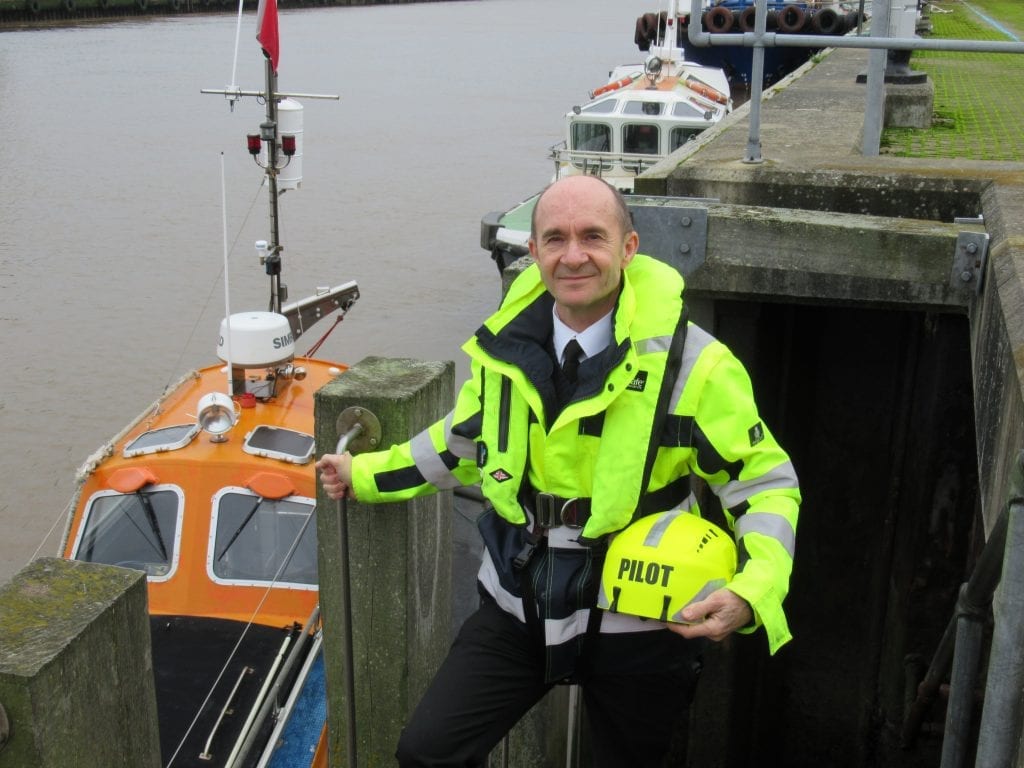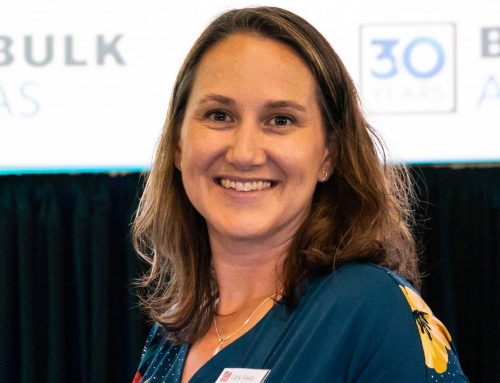Although born and raised in a small village in Berkshire, about as far from the sea as you can get, as a family we spent our summers at Calshot Beach overlooking the Solent. There I was able to watch all the cruise liners sailing from Southampton including the original Queen Mary and Queen Elizabeth to mention just two. I was mesmerized and at the tender age of 16 and a half I started my sea going career at Warsash School of Navigation in September 1972. I was sponsored as a Cadet by the British & Commonwealth Shipping Company founded by Cayzer Irvine. This group included the Union Castle passenger ships, Clan Line, King Line plus Bowater Shipping. When I joined there was a fleet of approximately 50 ships including passenger, general cargo, bulk carriers and tankers. It was a great opportunity to gain experience on so many different types of ships.
Warsash, in those days, was run on an almost military style with an 06.30 morning run and with our “Master at Arms” lurking in the bushes to catch any slackers. This was the first 3 months of a 4-year cadetship involving long periods at sea followed by technical training in the classroom at Warsash. I attained a 2nd Mates Foreign Going Ticket in 1976.
My very first ship was the Clan Menzies which I joined with 11 other cadets in February 1973. This was one of the Company’s cadet ships which had a dedicated training officer onboard although the vessel was a regular general cargo ship loading in Glasgow, Birkenhead and Avonmouth before setting off for East Africa via the Suez Canal.
During my time with Cayzer Irvine I sailed to many foreign ports, mostly Africa, India, South and North America and Europe. In those days Clan Line vessels were fitted with wooden hatch covers covered in tarpaulin held down with wooden wedges. The cargo was often loaded and discharged using the vessel’s own derricks which was an art form in itself.
Clan Line ships would carry a vast assortment of cargoes varying from everyday essentials such as soap, toothpaste and washing powder. Shoes would also be exported, with left and right feet dispatched in different crates to avoid “losses”. Heavier, larger items would include cars, steam engines and fire engines. Barrels of petrol were also carried on deck usually for delivery to St Helena and Ascension Island. The homeward journey cargoes consisted usually of tea, coffee, palm oil and copper ingots. The King Line bulk carriers mainly traded in iron ore, coal and grain from all over the world. My job as a Deck Officer was to make sure the cargoes were loaded correctly and in the correct holds and always involved the use of the Clan Line loadicator with its brass weight and gimbals to ensure stability of the ship was maintained.
All the company vessels adhered to a strict hierarchy and dress code. The Captain, or “Old Man”, oversaw everything whilst his deck officers underwent the daily routine of navigation and ship maintenance. His engineering department ran the machinery and any maintenance or repairs and the Purser, otherwise known as the Chief Steward, made sure the ship was clean and tidy and organised the catering. This department was very important because all the crew looked forward to meal times which broke up the normal routine. In Clan Line a curry was always on the lunchtime menu as most of the non-officer crew were from India or Bangladesh. Many of my era will affectionately remember ‘armpit curry’.
The wearing of uniform had its own code where full reefer uniform was worn in the UK. As the vessel proceeded into warmer climes, we would change into Red Sea Rig which dispensed with the heavy reefer jacket and a short sleeve shirt with epaulettes was worn. On sailing into the Tropics the trousers were replaced with white shorts along with long white socks and canvas shoes. Whether on duty or during meals uniform was always worn with rank insignia on display. Only when not on duty in the smokeroom and bar during the evening could this be relaxed and “civvies” be worn.
Navigation at sea has changed considerably from those days. As a 2nd officer I navigated around the world using a sextant and navigation tables. There was no calculator and everything was done using Burton’s Nautical Tables and an Almanac. As time progressed, a wonderful system called GPS appeared, however one particular senior Master didn’t trust it and I still had to navigate using my sextant. Being able to navigate using the sun and stars was a wonderful feeling which modern sailors will never experience.
Unfortunately, as containerization became more prevalent the old-style cargo vessels became redundant and slowly Clan Line scrapped or sold many of its fleet. A further brief spell at Warsash saw me finally attain my Masters Foreign Going Ticket in 1982. I subsequently joined Gardline Shipping Ltd which was a survey company operating mainly in the North Sea, reaching the dizzy heights of Captain in 1983 when assigned to the Gardline Tracker in Aberdeen. I was 27 years old. I remained at Gardline for 5 years, undertaking a wide variety of contracts mainly in Scotland and some for the Ministry of Defence (which I can’t write about but once involved being chased by a torpedo). Gardline’s home port was Great Yarmouth so it was a natural progression to train as a pilot there when the opportunity arose in 1989.
Thirty-one years later and having helped train a further 16 men to pilot, many who have retired or moved on, I felt it was time to retire from full time piloting. In all those years I completed approximately 19,000 acts of pilotage. When I commenced my training in 1989 many of the vessels were underpowered and operated with just a single engine and no bowthrust. With an air start engine, transferring from engine ahead to astern could often take up to 20 seconds which made berthing very interesting especially in a strong tidal river. I soon learnt how to manoeuvre vessels stern first using an anchor and sometimes the Port’s small tug, Hector Read with an excellent skipper, David Ling, who taught me everything about tug work. Sadly both now gone.
As years went by, ships became better equipped and the offshore supply vessels more powerful. In many respects the job of a pilot in Great Yarmouth is so much easier than when I started but still a challenge with no two days the same. The days of taking a fully loaded coaster through Haven Bridge on a full flood tide and backing into the River Bure (affectionately known as “The Creek”) are long gone. However, it is equally stressful boarding one of the Navy’s newest destroyers, HMS Dauntless and piloting her into Gt Yarmouth’s new Outer Harbour.
A typical day as a pilot in Great Yarmouth would start with a phone call at 05.00 hrs for the morning rush of offshore supply vessels arriving for either crew change, equipment, bulk cargo, or stores to service the nearby gas platforms and drilling rigs. I tried to organize a short break around 09.00 hrs for myself and the boat crew to grab breakfast. The shift would continue to 18.00 hrs and during that time there could be several cargo vessels which often required backing out the whole 2 miles of the River Yare. Due to the vagaries of the offshore industry some days would be quieter than others. With the development of an outer harbour the pilot service had to increase it’s skill base to accommodate vessels up to 200 metres in length including cruise ships, car carriers, large bulk carriers and windfarm construction vessels (jack-ups). We used simulators to assist with our training for this new enterprise.
Once onboard a vessel and having been escorted to the Bridge I would take over the “Conduct” of the vessel and would therefore be in charge of the navigation. It is therefore important to set up a good relationship with the Captain and bridge team so that they have confidence in my ability. Then it is down to my experience to pilot the vessel safely into port and alongside the quay.
Of course, as a pilot, it is important to be aware of your own personal safety at all times. I wore appropriate PPE which includes lifejacket, helmet, safety footwear, high-viz clothing, gloves and latterly face masks due to Covid-19. I relied heavily on the coxswain and deckhand to position the pilot cutter safely alongside the ship I was to board. It then comes down to timing and agility in transferring to the rope and wooden slatted pilot ladder for the climb to the deck. If I noticed any irregularities in the pilot ladder I would inform the ship’s crew to have it remedied immediately and notify my colleagues.
I am a member of the UKMPA (United Kingdom Maritime Pilots Association) and every year, along with IMPA and EMPA, undertake a month-long survey of pilot ladders worldwide. The results do not always make happy reading for pilots but it highlights the importance of pilot ladder safety. Boarding a ship in all weathers is a dangerous occupation and can result in fatalities.
That is why I have volunteered with the RNLI for the last 30 years, the last 3 as Lifeboat Operations Manager at the Great Yarmouth and Gorleston Station. I have had to work it around my shift pattern but now I have mostly retired I have more time to dedicate to a cause close to my heart.
The reason I remained at sea for so long comes down to working with like-minded colleagues and enjoying their company. Travelling around the world kept me in the Merchant Navy for 17 years. However, coming ashore to be with my wife and children made piloting very attractive as I was able to continue to ship handle which is my passion and hopefully have passed on my knowledge and skill to the many pilots I have trained
Captain Lindsey Wigmore has recently retired.
UK-Ports.org is grateful to him for sharing his experiences



